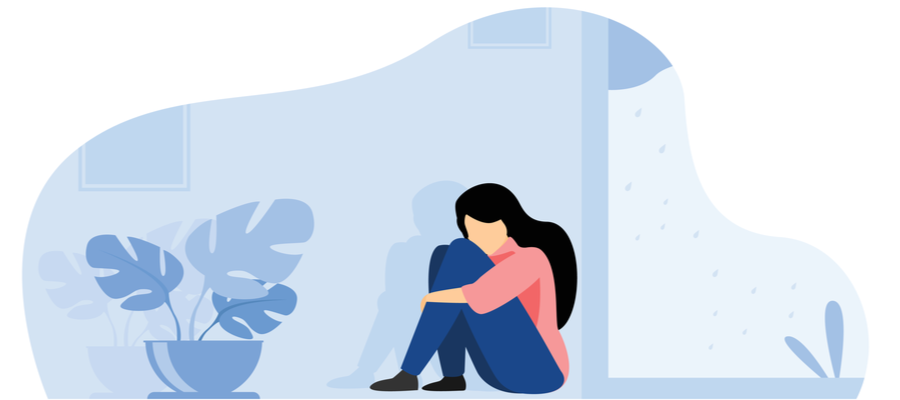Addressing pandemic-related isolation and loneliness from an eLearning perspective
Remember, in elementary school, when your teacher would turn from the blackboard at the exact moment the class clown was performing their latest trick? “You,” the teacher would say, “come and sit over here!” And the class clown would dejectedly make their way to the designated troublemaker’s desk at the front of the classroom—a desk that was, usually, removed from all the other desks. Or, maybe the teacher went as far as to ask the class clown to stay behind at recess, fold their hands over their knees, and remain quiet for fifteen minutes—an interminable punishment for a child.
Occasionally, that’s what this pandemic-inspired solitude feels like: a punishment.
And what’s more upsetting than a punishment for a crime you did not commit? Such are the conditions that many students and educators have endured for almost a year. It is easy to think of remote learning—specifically, remote learning that is not “voluntary”—as something of a relegation into unfamiliar educational territory. The catchphrase often uttered to appease anyone who might bemoan the current circumstances is that, though they may be trying and unpleasant, at least they are shared. We’re all in this together. … But are we, really? Though solidarity is certainly a vital instrument for enduring a crisis like a global pandemic, it is imperative that it should not be mistaken with commonality. We remain, after all, individuals. And although we may all be “in this together,” each experience is unique and personal.
A cross-sectional survey conducted by University of Miami researchers found that 65% of the 1,008 participants surveyed reported increased feelings of loneliness since the implementation of pandemic related distancing and confinement regulations (Horigian, V., Schmidt, R. D., & Feaster, D., 2020). This represents 655 individuals who are “in it together,” yet left feeling alone. So, it can be suggested that the mere existence of shared experience does not represent a solution to isolation. How, then, might students mitigate some of this loneliness, and how might their educators do the same?
Dr David Dozois, a psychology professor at Western University, explained to CTVNews that it was important to “normalize” sentiments of isolation and loneliness during the COVID-19 pandemic. Now, what might “normalizing” loneliness look like in an eLearning environment?
Here are a few things to consider:
- Resource refresher: It can be a good idea for educators to remind students of university services and resources at their disposal throughout (and after) the pandemic. Though mental health might not be part of a particular course’s curriculum, it remains “significantly associated with academic outcomes among college students” (Eisenberg, D., Goldberstein, E., & Hunt, B., 2009). There are several mental health services and resources available to students and faculty alike. Higher education institutions work with health and wellness professionals who actively monitor complicated situations and the individuals affected by these situations. Concordia University’s Mental Health page, for example, provides self-help tools as well as helplines and text-lines. On the page, you can also find an article presenting online mental health resources related to the coronavirus pandemic. Drawing attention to the services and resources available to students and faculty normalizes isolation by acknowledging that if help should be required, it is available to anyone who needs it.
- Anonymous forums & guided conversation: Another possibility for educators and students is to promote and facilitate discussions on the subject. One objective of mental health campaigns is to eliminate the stigma surrounding the subject. To that end, offering students a platform or a forum where they might anonymously engage with one another could be a solution to alleviating some of the isolation and loneliness experienced in confinement. Free software, like SurveyMonkey’s online survey tool, can be used by professors to check-in on their student’s wellbeing. From there, a forum can be created using, for example, FORUMOTION, where students and their educators can engage in further discussions.
- Emphasis on group learning & collaborative activities: Though the first two suggestions could be regarded as extra-curricular, it is also possible for educators to create opportunities for students to feel less isolated. To achieve this, teachers can develop assignments and activities (graded or ungraded) that are inherently collaborative: seminar discussions, peer-reviews, and group projects can all be used as alternatives for evaluating or cultivating competencies that might otherwise be evaluated or cultivated on an individual basis. By creating opportunities for students to engage in more cooperative, dynamic learning activities, educators can promote interaction, while preserving their pedagogical trajectory.
Students and teachers have had to demonstrate tremendous degrees of adaptability and resilience throughout the pandemic. For many, migrating to and experiencing the eLearning environment has been an isolating and solitary exercise. Acknowledging that it has been demanding and taxing can be the first step toward normalizing the loneliness experienced by student and educators. It’s important to remember, too, that as with the recess-long punishment of our dear class clown from the opening paragraph, this too shall pass!
Author:
Josh Quirion
Learning Experience Designer @KnowledgeOne |
Writer & Editor-in-Chief at yolkliterary.ca
Josh Quirion is a former journalist and CEGEP instructor. He holds a B.Ed. from Bishop’s University and an M.A. in English Literature and Creative Writing from Concordia University. Quirion published his first book, Towners & Other Stories (Shoreline Press), in 2020.







Leave A Comment